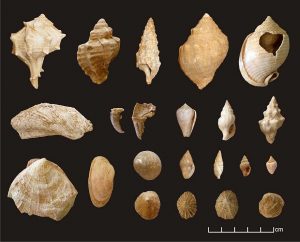The systematic collection of remains of marine and land molluscs has been integral to the excavation on the Kephali hill at Sissi. The aim of the shell study is to allow insights into the life cycle of shells, from the procurement of molluscs, to preparation/working, consumption and final discard on the basis of detailed faunal, taphonomic and contextual analysis of the material. In particular, the organisation of mollusc food consumption, the manufacture of shell artefacts, as well as the utilisation of shells in different contexts are among the issues that will be explored on various temporal (synchronic, diachronic) and spatial scales (domestic, communal, regional, interregional).

Commonly encountered species in the shell assemblages from Building CD and Building E (Photographs: R. Veropoulidou, Image processing: N. Valasiadis).
The study of the shell assemblage commenced in 2009 and continued in the following two seasons (2010 and 2011) prioritizing the analysis of shells from Building CD and Building E, which are considered by the excavators (Dr Letesson and Dr Devolder, respectively) to be mainly of LM III date. In total, the studied assemblage comprises 3574 shells, of which 3173 are the remains of 42 different marine molluscs, sea-urchins and crabs (Figure 1). There are also 401 remains of land snails, of which 61% is pre-modern.
The vast majority if shells from Buildings CD and E were gathered from the sea-shore, where procurement methods are simple and do not require any significant effort or time investment. However, an array of variables (species ecological requirements, size, variety, presence of worn-shells) suggests that different methods were employed in each environmental niche and for the procurement of particular species. Moreover, the focus on only some species from the great variety offered indicates selectivity and might be taken as evidence of specialized gathering practices, at least as regards food procurement.
84% of shells from Buildings CD and E and at least 13 different species (e.g. limpets, top-shell, sea-urchin, crab, Noah’s ark, and horn-shell) may be safely assumed to represent remains of food consumption. The lack of differences in patterns of mollusc food consumption between the two buildings implies commonly shared food habits and dietary practices. Moreover, the fact that the particular species of shells, charred plant remains and animal bones were found mixed suggests that there were no discriminations between foodstuffs. Finally, the spatial distribution of shell remains in both buildings suggests that molluscs were consumed as food in both domestic and more communal occasions.
Additionally, all three species associated with the manufacture of purple dye in the Aegean (Hexaplex trunculus, Bolinus brandaris, Stramonita haemostoma) are present in the studied assemblage. Though their fragmented state is consistent with purple-dye manufacture, their low numbers do not allow us to infer systematic production of dye on site, but rather the possibility of small scale in situ production, accompanied by subsequent removal of production waste.
Other mollusc species might have been collected by accident (e.g. grooved helmet, striped Venus, hairy ark), brought to the site alongside materials from the beach (seaweed, sand) or as curios for decorative (e.g. cowrie shell, cone) and other special purposes (e.g. trumpet triton). The corpus of worked shells comprises only twelve examples (six perforated specimens, five specimens used as expedient tools and one specimen possibly used as a musical instrument).
It is anticipated that the integration of all lines of bioarchaeological evidence (animal and fish bones, plant remains and marine and land molluscs) in combination with the final stratigraphic and contextual information in the following study seasons will allow valuable insights into the economy and society of prehistoric Sissi.
Dr Rena Veropoulidou
Museum of Byzantine Culture, Greece